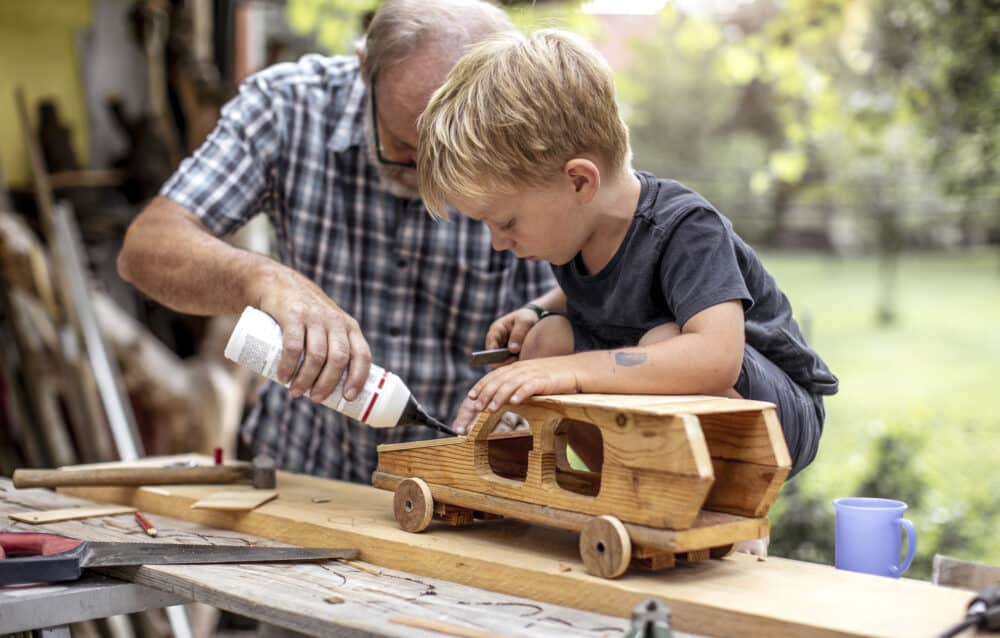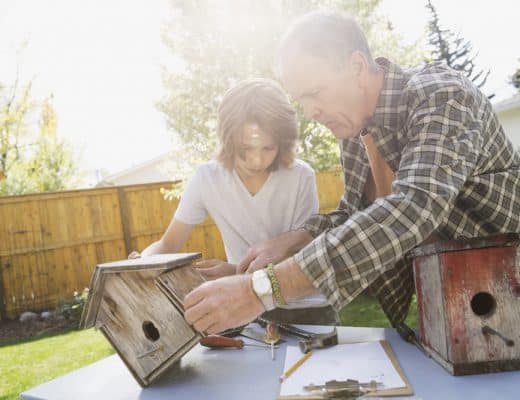Woodworking is a wonderful activity that can be enjoyed by kids and adults alike. Not only does it provide a great opportunity for creativity, but it also helps develop important skills such as problem-solving, hand-eye coordination, and patience.
However, when it comes to woodworking for kids, safety should always come first. In this article, we will explore the basics of woodworking and guide you on how to build simple and safe projects together with your children.

Understanding the Basics of Woodworking
Before diving into any woodworking project, it is essential to understand the basics. This includes knowing the right tools and safety measures to ensure a successful and accident-free experience.
Woodworking is a timeless craft that allows individuals to create beautiful and functional pieces from wood. Whether you’re a beginner or have some experience, it’s important to have a solid foundation in woodworking techniques and knowledge.
Essential Tools for Beginner Woodworkers
As a beginner woodworker, having the right tools is crucial. Some essential tools for kids include:
- A small handsaw: This tool is perfect for making precise cuts in wood. It’s lightweight and easy to handle, making it ideal for beginners.
- A hammer: A basic tool that is essential for woodworking. It’s used for driving nails into the wood and can also be used for other tasks such as removing nails or tapping pieces into place.
- Safety goggles: Protecting your eyes is paramount when working with wood. Safety goggles provide a barrier between your eyes and any flying debris or wood particles that may be generated during the woodworking process.
- A tape measure: Accurate measurements are crucial in woodworking. A tape measure allows you to measure and mark the wood precisely, ensuring that your cuts are accurate and your projects are well-constructed.
- Sandpaper: After cutting and shaping the wood, sandpaper is used to smooth out any rough edges or surfaces. It’s an essential tool for achieving a polished and professional finish.
These tools are easy to handle and will allow your child to complete simple woodworking projects with ease. As they gain more experience and confidence, they can gradually expand their tool collection.
Safety Measures in Woodworking for Kids
Prioritizing safety in woodworking activities is of utmost importance. Teach your child the following safety measures:
- Always wear safety goggles to protect the eyes. Woodworking involves sharp tools and flying debris, so it’s crucial to protect your eyes from any potential hazards.
- Use clamps or a vise to secure the wood in place while working. This ensures stability and reduces the risk of the wood moving unexpectedly, preventing accidents.
- Never leave power tools unattended. Power tools can be dangerous if mishandled or used improperly. Always supervise your child and ensure that power tools are used responsibly.
- Keep fingers away from the cutting area of the tools. It’s important to maintain a safe distance from the cutting edge to avoid any accidental injuries.
- Always cut away from the body to avoid accidents. By cutting away from the body, you reduce the risk of the tool slipping and causing harm.
By teaching your child these safety measures, you are instilling good habits that will stay with them throughout their woodworking journey.
The Importance of Supervision in Woodworking Activities
Supervision is key when it comes to woodworking for kids. Make sure to supervise your child during the entire process, especially when using sharp tools or operating power tools. By doing so, you can guide them, ensure their safety, and encourage their creativity.
Woodworking is a wonderful way for kids to develop their problem-solving skills, enhance their hand-eye coordination, and unleash their creativity. By providing a safe and supervised environment, you can nurture their passion for woodworking and help them build a lifelong love for this rewarding craft.
Starting with Simple Woodworking Projects
Now that you have a grasp of the basics, it’s time to start with simple woodworking projects that your child will enjoy. These projects are designed to be easy, safe, and fun.
Woodworking is a wonderful way to foster creativity and develop essential skills in children. As they embark on their woodworking journey, they will not only learn how to work with their hands but also gain a sense of accomplishment from creating something tangible.
Choosing the Right Materials for Your Project
When starting a woodworking project, it’s important to choose the right materials. Opting for softwoods such as pine or cedar is best for beginners as they are easier to work with. These woods are readily available at most hardware stores.
Softwoods are not only easier to cut and shape but also more forgiving when it comes to mistakes. This allows children to experiment and learn without the fear of ruining expensive materials. As they gain confidence and skills, they can gradually move on to working with hardwoods.
Step-by-Step Guide to Building a Birdhouse
A birdhouse is a classic woodworking project that kids will love. Here’s a step-by-step guide to building one:
- Measure and cut the wood into the required pieces for the birdhouse – four walls, a bottom, and a roof.
- Use a hammer and nails to assemble the walls together.
- Attach the bottom piece to the walls using screws or nails.
- Attach the roof by nailing it to the top of the walls.
- Sand down any rough edges and decorate the birdhouse as desired.
- Mount the birdhouse on a sturdy post or tree branch.
Remember to supervise your child during each step and let them take the lead while you assist when needed. This project will not only provide a home for birds but also a sense of accomplishment for your child.
Encourage your child to observe the different bird species that visit the birdhouse and learn about their habits and behaviors. This can spark an interest in nature and create a deeper connection with the environment.
Creating a Simple Picture Frame
Another great project for kids is creating a simple picture frame. Here’s how:
- Measure and cut four pieces of wood into equal lengths.
- Miter the ends of the wood at a 45-degree angle.
- Affix the pieces together using wood glue.
- Sand down any rough edges and paint the frame.
- Insert a favorite photo and display the frame proudly.
This project allows kids to showcase their artwork or cherished memories in a personalized frame. It also teaches them the importance of precision and attention to detail, as they strive to create a frame that perfectly fits their chosen photo.
Encourage your child to experiment with different paint colors, textures, and embellishments to make their picture frame truly unique. This will unleash their creativity and help them develop their own artistic style.
Advancing to More Complex Projects
Once your child has mastered the basics and gained confidence in woodworking, it’s time to move on to more complex projects. This will further enhance their skills and expand their creativity.
Building a Small Bookshelf
A small bookshelf is a fantastic project for expanding woodworking skills. Here’s a basic guide:
- Measure and cut the wood into the required pieces for the bookshelf – two sides, a top, a bottom, and shelves.
- Assemble the pieces by using screws or nails.
- Sand down any rough edges and paint or stain the bookshelf.
- Place your child’s favorite books or toys on the shelves for a functional and decorative piece.
This project will not only provide a useful storage solution but also instill a sense of pride in your child for completing a more complex woodworking project.
Crafting a Wooden Toy Car
Turning a simple block of wood into a toy car can be a thrilling project for both you and your child. Here’s how:
- Shape the wood into the desired car shape using a handsaw or carving tools.
- Sand the surface until smooth.
- Add wheels by drilling holes and attaching them securely.
- Paint or decorate the car to your child’s liking.
This project allows your child to not only create their own toy but also improves their fine motor skills and boosts their imagination.
Tips for Making Woodworking Fun and Educational
To make woodworking enjoyable and educational for your child, consider the following tips:
Incorporating Learning Opportunities in Woodworking
Woodworking offers numerous learning opportunities. You can teach your child about measurements, fractions, and the properties of different types of wood. Encourage them to problem-solve and think critically throughout the process.
Keeping the Fun in Woodworking Projects
Woodworking should always be fun for kids. Allow them to choose projects that interest them and let their creativity shine through. Celebrate their achievements, no matter how small, and create a positive and enjoyable woodworking environment.
The Benefits of Woodworking for Kids
Engaging in woodworking projects offers various benefits for children. Beyond the joy of creating something with their own hands, woodworking provides opportunities for growth and development.
Developing Motor Skills through Woodworking
Woodworking requires hand-eye coordination, fine motor skills, and patience. By participating in woodworking projects, your child can strengthen these skills and enhance their dexterity.
Encouraging Creativity and Problem-Solving Skills
Woodworking encourages creativity and problem-solving. Children are given the freedom to explore their ideas and come up with solutions when faced with challenges during a project. This fosters critical thinking and innovation.
Building Confidence and a Sense of Achievement
Completing woodworking projects provides a sense of accomplishment for children. As they see their finished creations, they gain confidence in their own abilities and realize that they are capable of creating something valuable.
Woodworking is a rewarding activity for kids that promotes creativity, skill development, and self-confidence. By understanding the basics, starting with simple projects, and gradually advancing to more complex ones, your child will build a solid foundation in woodworking. Remember to prioritize safety, supervise them closely, and most importantly, make sure they have fun every step of the way. Happy woodworking!



